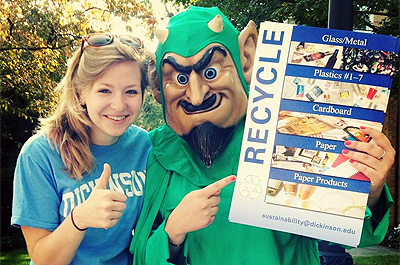Climate Action 2.0

It’s one thing to sign a pledge; it’s another altogether to actually follow through. In 2007, when President William G. Durden ’71 signed the American College & University Presidents’ Climate Commitment, the college already had been actively shrinking its carbon footprint.
But the pledge set into motion an even more ambitious strategy: the Climate Change Action Plan (CCAP). The college set out to conduct a greenhouse-gas-emissions inventory, integrate sustainability into the curriculum and transition to climate neutrality by 2020.
Dickinson is nearing the halfway mark of that pledge, and on Jan. 25, Neil Leary, director of the Center for Sustainability Education, and Ken Shultes ’89, associate vice president for campus operations, reported on the college’s progress: An inventory completed in 2008, several measures implemented and sustainability concepts woven into the fabric of the curriculum. Leary and Shultes then outlined next steps, including the newly formed Climate Action Task Force.
“We’ve put our reputation on the line,” Leary said. “Dickinson has made progress toward its goals, but meeting these goals requires further planning and renewed effort.”
Those efforts include the creation of four teams to review energy efficiency and conservation, transportation, renewable energy and new construction. The teams, led by faculty and staff and supported by student-research assistants, are charged with developing a 2.0 version of CCAP.
A draft of that plan will be presented to the campus community in late April, and the task force anticipates implementation in September. Considerations range from simple reminders to turn off the lights to major building retrofits, programs encouraging employees to car pool or use public transit and generating much of our electricity on campus with solar energy.
“We need to think small and big, and recommendations need to include costs,” Shultes said. “Incrementalism really matters. We have 3,100 people on this campus, and a small change can make a big difference.”
Published April 11, 2013